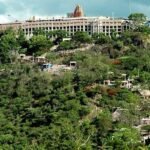There are several popular places to see near Dindigul - Tourist Places
In Tamil Nadu, Dindigul is known for its thriving culture, past and lovely surroundings. With a well maintained fort and industry that thrives, plus beautiful surroundings, Dindigul draws tourists. This guide explores the best areas in Dindigul and offers information about its history and present sights.
The Best Places to See in Dindigul
The ancient city of Dindigul features several historical sites, treasure rooms of cultural moments and admirable buildings. If you have Dindigul on your itinerary, you won’t want to skip these must-see tourist attractions.
Built atop a hill with views of Dindigul, the Dindigul Fort represents an important historic landmark. Although Muthu Krishnappa Nayak began the fort’s construction in the 17th century, it was Hyder Ali and Tipu Sultan who supplied greater protection for the area. Fort Mangalam allows visitors to enjoy a stunning scenery of Dindigul and the hills that surround the city. Anyone interested in history will find joy in watching the old walls, unusual passageways and lasting buildings of the fort.
2. Sirumalai Hills
People from nearby villages become curious about it and come to discover it just 25 km from Dindigul. Sirumalai Hills is a great spot for hiking and trekking and birdwatching as well, thanks to the greenery, good weather and wonderful scenery. The Sirumalai hills bring a sense of calm to people who live in the city.
3. Thadikombu Perumal Temple
Since it is in Dravidian style and consecrated to Lord Vishnu, this temple is truly respected and becomes a very holy place. Thousands of worshipers from throughout Dindigul gather at the temple for Brahmotsavam.
Despite Dindigul being only a short drive from Kodaikanal, the place should definitely be visited if you happen to be there. Named the “Princess of Hill Stations,” Kodaikanal brings visitors comfortable temperatures, stunning overlooks and landmarks including Kodaikanal Lake, Coakers Walk and Pillar Rocks.
5. Begambur Big Mosque
Hyder Ali was responsible for the beginnings of the Begamabur Big Mosque which stands today as the first mosque in Dindigul. What makes the mosque unique is a reason for people to include it on their list of destinations in Dindigul to seek the region’s Islamic roots.
6. Sri Kottai Mariamman Temple
The main religious and cultural life of Dindigul centers around the Goddess Mariamman temple. A large group of pilgrims come to the temple each year during the festival from various regions in Tamil Nadu.
7. Abirami Amman Temple
Other people interested in religion should include a visit to the Abirami Amman Temple in Dindigul. Many people come to the Temple of Goddess Abirami all year, as the festivals keep it bustling.
8. Dindigul Lock Manufacturing Cluster
Learning about Dindigul’s history is easy by visiting its lock manufacturing industries. Anyone visiting Dindigul should watch handmade locks being produced and gain knowledge about the time-honored methods responsible for the city’s reputation in stone.
9. Silver Cascade Falls (Kodaikanal)
If Kodaikanal is where you’re headed, a stop at Silver Cascade Falls will surely be appreciated by everyone. Pure, running water over rocks looks very soothing, particularly during the monsoon season.
10. Anjaneyar Temple
The very important Anjaneyar temple faces Lord Hanuman and is located in Ayyampalayam region. You should see the temple because it is calm and has deep importance to the religion.
A mixture of culture, great history and impressive nature makes Dindigul exciting for all kinds of visitors.
Information on Dindigul District’s history
The rock fort is what marks the founding of the city of Dindigul. Many changes throughout history have reshaped this fort.
- Dindigul became a strong Chola fortress after Karikal Chol became king at the start of the 1st century. At this point, the cholas brought all their power under one rule.
- The Pallavas achieved power in the 6th century around where the Cholas are situated. Still, in the 9 th century the cholas once again seized control. Since the 13th century, authority fell into Pandyan hands.
- Until 1985, the district of Dindigul was classed as a part of Madurai. This happened only after Thiru M. Madhavan campaigned for the division.
- During the Polygar Wars, a local queen and two leaders jointly used the fort as a main base for military operations.
- In 1559, authority of Vijayanagara Empire was transferred to the Madurai Nayaks. During King Muthukrishna Nayak’s period, great improvements were added to fort defenses.
- From 1742, the Mysore rulers were in charge of the Dindigul following British handover. At the time of Haider Ali and Tipu Sultan, the fort was strengthened. British sovereignty which made the British regime official, was reached by 1790 through the efforts of the British East India Company.
A Look at Dindigul’s Demographics Based on the 2011 Census
During the 2011 census in Dindigul, there were 207,327 people and women actually outnumbered men with a sex ratio of 1012 females for every 1000 males which is much higher than, the national average for India. A big population of children in Dindigul was below age six, amounting to 19,603. Out of these, 10,126 were male and 9,477 were female. Out of the review population, 81.69% could read and write which is way higher than the national average of 72.99%. 7.58% were SC and 0.07% ST
Dindigul's Labour Market
- Of the 77,813 people employed in Dindigul, many were working in different sectors. Among the results were:
- 387 cultivators
- The area employs 366 agricultural laborers.
- 5,328 employees work in household industries.
- Another 68,163 people are also workers.
The 3, 569 marginal workers included cultivators, agricultural labors and others. The city’s urban density was clear due to its population of 53573 housed in various households.
The Religions Found in Dindigul
The 2011 religious census discovered that Dindigul’s population consisted of:
- 69.11% Hindus
- 14.17% Muslims
- 16.59% Christians
- Most Sikhs, Buddhists and Jains fall into small percentages of the Indian population.
The Figure Shows Urban Agglomeration and the Growth of Literacy
In Dindigul, the urban agglomeration had a population of 292, 132, with about the same number of girls per thousand boys as the average. Around 89.1% of people in Dindigul urban agglomeration can read or write. Male literacy rate was 93.41%, a little higher than the 84.83% female rate.
How does city population increase and how many people live in slums?
The rate of growth in Dindigul has fluctuated throughout several decades. During the 70s, the city more than doubled in size, yet after that growth slowed down. Urban issues became clear in the early 2000s since the slum population grew from just 16% in the 1990s to 43% in 2001. In total, 15 slums were reported in the town and they housed 85,235 residents in 16,841 families.
Densities in Population and Languages
Dindigul city occupied an area of 14.01 km 2 , with 153 inhabitants per hectare living in the region in 2001. The population surged to 2,218 people per square kilometer in 1971 and it was easily seen that people were gathered more closely in the center and along principal roads. While most people talk Tamil with their families, English is widely spoken in schools, government buildings and companies across the city.
Dindigul’s population groups reflect what the city’s traditions involve as well as the hurdles it encounters in its progress and growth.



